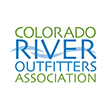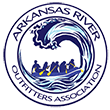10 Things River Veterans Don’t Do
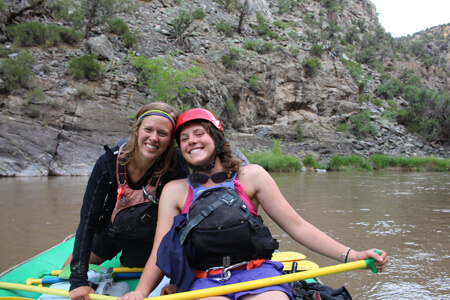
Whether this is your first time whitewater rafting (Woohoo!) or you are looking for some pro tips to improve your next trip, I consulted with some of our senior whitewater rafting guides to create a list of the top 10 mistakes we see on the river. In the world of skiing, a “Gaper” is someone who clearly is out of their element and stands out like a sore thumb. While there is no official term for such individuals on the river, the same concept applies. We can tell. It does not take much guesswork to discern those who know what they are doing from those who are still figuring things out… With this in mind, we went ahead and prepared a handy guide so you will be fully prepared for your next whitewater rafting adventure: 10 Things River Veterans Don’t Do 1. Wear Flip Flops The fast water flows that make whitewater rafting so much fun are also notorious for sweeping up flip flops. Currents are extremely strong requiring secure footwear. Most river guides wear sandals that fasten around their ankles like Chaco or Teva sandals. Their customizable fit ensures the river won’t snatch them off! 2. Wear Cotton Cotton is a bad idea when whitewater rafting because it takes too long to dry out after getting wet. Cotton loses its ability to insulate once wet meaning you will feel cold until your clothes completely dry out. Instead of cotton, choose something that wicks away water like wool or fleece. These options keep you warm even when soaked with water from the rapids. 3. Forget Sunscreen All of our whitewater rafting trips occur at high altitude causing the sun’s rays to be much stronger. At higher elevation, wearing a sunscreen with an SPF of at least 30 will protect your skin. For whitewater rafting, look for something waterproof that won’t smear away when splashed. Many brands offer sport-specific blends of sunscreen designed to withstand sweat and water contact. These tend to be creamier formulas too, meaning you’re less likely to get sunscreen in your eyes (an extremely important detail). 4. Get Dehydrated Another thing to watch for at high altitude is dehydration. Due to the reduced amount of oxygen in the air, dehydration sneaks up on visitors who are used to living closer to sea level. Aim to drink at least two liters of water per day and you’ll be fine. Aboard all of our rafts we provide water for guests so if you’re ever feeling thirsty – just let your guide know! 5. Litter One of our core values is preserving the environment and educating others on the value of living sustainably. Our guides are trained in the fundamentals of Leave No Trace ethics meaning we literally pack everything away and take it with us. The goal is to seem as if we were never there. The magic of the rivers we raft is in how pristine and gorgeous their surrounding habitats are. This is something the entire community appreciates which is why we feel it is our duty to protect and preserve them for future generations to enjoy. 6. Get Hangry Avoid the horrible irritability that stems from hunger by taking full advantage of all the food we provide! Start your day off with our complimentary continental breakfast to ensure your body has the right fuel for whitewater rafting. Paddling through rapids takes a lot of energy, burning over 300 calories per hour so eating a balanced meal beforehand and replacing calories throughout the day is essential for feeling your best on the water. All our full day trips include multi-course lunch spreads and are happy to accommodate special diets (gluten free, vegan, etc) so chances of incurring hangriness when rafting with us are pretty slim. 7. Lose their Sunglasses Whitewater rafting puts sunglasses in a high risk environment. Just like with flip flops, sunglasses are too easy to accidentally knock off and lose to the river’s current. Before becoming a professional in the world of whitewater rafting, I had no idea why people would expose their designer sunglasses or prescription eyewear to the possibility of getting lost in the river. I quickly learned this problem has an easy solution: glasses can be secured with “eyewear retainers”, essentially lanyard for sunglasses. They are a river necessity and can be purchased in our gift shop right before you hit the water. 8. Expect a Free Ride When whitewater rafting, prepare to put in some solid effort while paddling. The currents and rapids we take on are strong and guides are entirely relying on their crew – you – as the engine to power the raft through. Most trips have a mix of mellow stretches, ideal for admiring scenery and relaxing, and intense rapids requiring full steam ahead. Your guides will make it clear when the time for paddling occurs. As a member of a raft’s crew, it’s up to you to ensure your boat has the power to maneuver around and avoid obstacles like your guide intended. 9. Remove their PFDs Personal Flotation Devices (PFDs) are fitted to guests before arriving anywhere near the water, ensuring a safe snug fit. It might feel tight and awkward at first, but there is a good reason: In the case of falling overboard, the lapels of your PFD are what we’re relying on to pull you back in! The last thing anyone wants is to pull an empty PFD back into their boat. If the fit is unbearable, don’t be shy – any of our guides would be more than happy to adjust the fit for you (never do it yourself). 10. Have a Bad Attitude Rafting is literally all about going with the flow! Every stretch of river offers its own unique beauty in so many forms. There is always something gorgeous to admire and whitewater rafting is one of the best ways to immerse yourself in the beauty rivers offer. Whitewater rafting is also a ton of fun –
Rafting in Colorado? The Complete Guide to Keeping Mosquitoes Off Your Back
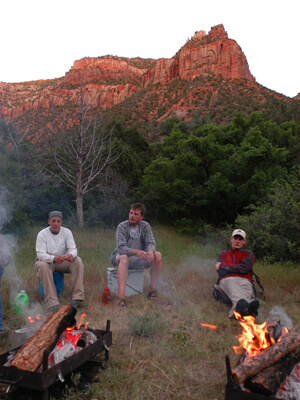
Whitewater rafting in Colorado is amazing, but you don’t want to return from your trip covered in bites. Don’t worry. This ultimate repellant guide has you covered! There are few experiences that offer the adventure, beauty, and excitement of Colorado whitewater rafting trip. There’s nothing like leaving civilization behind to immerse yourself in the powerful currents of Colorado’s famous rivers. A Colorado whitewater rafting trip has so much to enjoy! However, to make your excursion perfect, there’s just one thing to take care of: getting those darned skeeters off of you! Mosquito bites can put a damper on any occasion. Fortunately, this is an easy problem to deal with. To avoid coming home from your Colorado rafting adventure with your skin covered in bites, we present you with this complete guide to keeping mosquitoes off your back (and the rest of your body). Stay Away from Mosquito Hotspots Sometimes, the best way to win the war against mosquitoes is to choose your battles. This means avoiding areas prone to mosquitoes. By being around fewer mosquitoes, you naturally reduce the chances of being bitten. Thus, it’s important to understand where mosquitoes live. These obnoxious bugs breed in and around standing water. They love anywhere that’s damp and humid. Naturally, you won’t be staying dry when on a Colorado whitewater rafting trip. No need to worry though, our rivers flow fast enough to keep mosquitoes from settling. It’s the still water – the puddles and the ponds – that are dangerous. Unless you’re looking for a mosquito confrontation, you’ll do well staying away from still bodies of water. Set up camp somewhere dry. If the mosquitoes get in your tent, you’re done for! Avoid Peak Mosquito Hours Typically, mosquitoes are most active at dawn and dusk. These times are their peak feeding hours. If you’re out within this timeframe, you may be in for a bite! If you plan on taking a long hike, it’s best to begin before dawn or sunset. Maybe you’re more in the mood to sleep in and sneak in a short hike before hitting the water. If that’s the case, wait until early morning passes before going out. Just like with hiking, schedule your cooking and eating to avoid these peak hours so you don’t attract huge numbers of mosquitoes. Wear the Right Clothes Did you know mosquitoes have favorite colors? They’re most drawn towards dark colors like black, brown, gray, and blue. If you want to pass by mosquitoes unnoticed, simply opt for light colors. Long sleeves, long pants, and closed-toed shoes are your best friends when you’re passing through mosquito territory. You want to put as many layers as possible (or comfortable) between yourself and the little blood-suckers. There are even clothes you can buy that are treated with the repellent permethrin. While these don’t eliminate the need to apply repellent to your skin, they do serve as an additional deterrent. Choose the Right Mosquito Repellent There are many repellents out there, but the most well-known and time-proven is DEET. DEET was developed by the US Army in 1946 and is extremely powerful. The repelling effect lasts from ten to twelve hours, depending on the concentration in the product you choose. Combining a DEET-based repellent with permethrin-treated clothes will make you a walking anti-mosquito machine. Take note though as DEET can damage materials like spandex, vinyl, leather, and rubber. There’s no need to worry about what to wear – cotton, wool, and nylon are completely unaffected by DEET. Picaridin is another effective repellent. It was made in Europe in the late 1990s and has been in use in the US since the early 2000s. Picaridin’s effect lasts about eight hours. Unlike DEET, it doesn’t damage any fabrics or materials. Natural Repellents A lot of people like to avoid anything synthesized in a laboratory. If you prefer all-natural products, there are plenty of effective plant-based solutions you can use on your Colorado whitewater rafting trip. Lemon Eucalyptus Oil This is a trusted solution for keeping mosquitoes away. The Centers for Disease Control and Prevention has recognized lemon eucalyptus oil as being highly effective. You can easily make your own mixture at home. Just take one part lemon eucalyptus oil to ten parts sunflower oil and you’re good to go! Cinnamon Oil This little-known mosquito repellent is extremely powerful for warding off mosquitoes and even killing mosquito eggs. Be careful, though – concentrated cinnamon oil can irritate your skin. Prevent this by making a diluted solution: 1/4 teaspoon of cinnamon oil for every four ounces of water should take care of you. Soybean Oil There are many soybean based products on the market that provide long lasting protection from mosquitoes. These typically have a two-percent soybean content and can be found online or at natural food stores like The Lettuce Head here in Buena Vista. Don’t Forget About Protection While You Sleep It’s important to get the right bedtime anti-mosquito gear when you go rafting in Colorado. You’re most vulnerable when you’re asleep because you can’t defend yourself. If you’re extremely concerned, you can place a mesh net inside your tent to keep mosquitoes away. Keep flashlights off when you’re opening up your tent at night since mosquitoes are attracted to light. You don’t want to tip them off about the entrance to your safe zone! When it comes to snacks you may have brought, be sure to store all food and drinks in airtight containers away from your tent. The presence of food is sure to bring mosquitoes knocking at your door. Leave Your Perfume at Home! Keep in mind that mosquitoes follow strong scents. When they smell perfume, deodorant, or even aromatic lotions, they hone in for the kill. Safe yourself the hassle and don’t even make this one an issue. The easiest way to avoid mosquito bites, is to ditch the perfume or cologne and get in touch with your more wild side while on your Colorado rafting trip. (P.S. Here’s what to pack
Footwear FAQ: Can I Wear Flipflops?
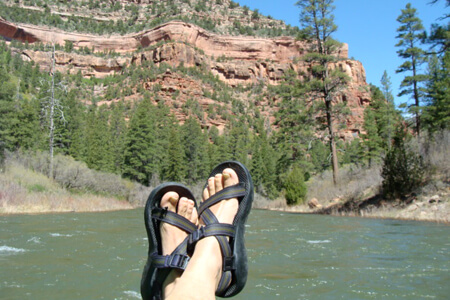
Trust us, you’re not the first to ask this question – it can be tricky figuring out what to wear if you are not used to fast flowing rivers. Here are all the secrets to keeping your feet happy while whitewater rafting. The first step is to leave your flipflops home. If you really can’t let go, leave them in the car at least so you have something easy to wear after your trip. Now, let’s meet our options: Booties Imagine a thick, mid-calf height neoprene sock with a zipper or some Velcro straps to fasten it on and a seriously grippy sole. These things are called booties and are the most popular footwear option among our guests. Booties trap water inside allowing your body heat to warm it up and keep your feet cozy all day. Most of our guests rent a pair of booties directly from us, we have the option to rent them separately or as a part of our “Be Warm!” package. Secure Sandals (AKA Chacos/Tevas) These sandals are a staple of any river rat’s wardrobe. Within this world, the most popular brands are Chacos and Tevas. To an untrained eye, there’s not much of a difference but there are a few subtle differences. Chacos use a loop system where you adjust the strap length to tighten or loosen the sandal. In my experience, the sole is beefier and it takes a few days for your foot to feel comfortable. Tevas are secured with Velcro straps and have a squishier sole. Chacos tend to be more popular on the river since they are a little more rugged. Old Sneakers If you have a beater pair of running shoes you don’t care about, these make a great option for rafting. Old sneakers work well because they have a nice thick sole and the laces fasten tightly to your feet preventing them from getting lost to the water’s currents. Before you don your old shoes, remember these will definitely have some sort of smell from the river water so make sure you’re fully willing to sacrifice them. Bonus: What about socks??? Slap on a pair of wool or neoprene socks and you will be set. Cotton socks are a terrible idea because they will get wet and stay wet throughout the trip keeping your feet cold. Socks are typically a good idea when wearing river sandals or old sneakers. When worn with booties, they do not offer much additional benefit so I suggest skipping them. Definitely stash a pair of cozy socks in your car for afterwards – your toes will thank you!
How to Protect Your Cell Phone
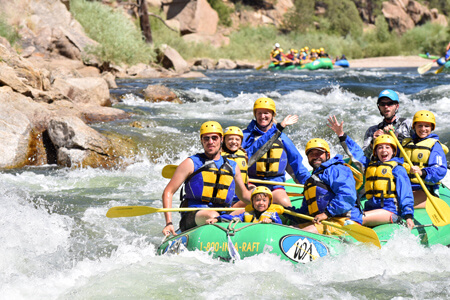
We all know cell phones and water do not go well together, so how does one protect a cell phone for a whitewater rafting trip? Our best advice: You Don’t. This is a bold claim to make, so let’s back it up. The reason I say don’t bother with protecting your cell phone is because there is no good reason to bring it along in the first place. When packing for your trip – ask yourself, “Why do I want this?”. Most folks don’t have the time to snap selfies while paddling (your guide will have a heart attack if you try and pull this off during a rapid). There are professional photographers posted up at the major rapids on our Browns Canyon rafting and Arkansas River rafting trips so you’ll still get your action shots. Slap a GoPro on top of your helmet or pick up a disposable waterproof camera from our gift shop and you’ll be set to capture the memories. With the need for photos eliminated, and inconsistent cell service in most of the areas we raft in, my advice is to leave your phone in the car, but if you must, here are your options: 1. Waterproof If this is your first time rafting, definitely plan on getting wet. Even your secret dry spot in the center of the raft is bound to get wet at some point. With this in mind, waterproofing your phone is a must. There are a few different approaches like waterproof cellphone cases or sealable waterproof pouches – just make sure you do a test at home first to verify water will not sneak in. 2. Secure I almost always keep my cell phone in a pocket. Most of the time this approach is fabulous, except of course, on the river. For whitewater rafting, you’ll want to make sure your phone is physically attached to something else. For example, this can be something like a wearing a necklace style waterproof pouch (available for purchase at our gift shop). These work well because your phone is easily tucked into your PFD where it is both super secure and easily accessible. Another option is storing your phone in a drybag attached to the raft. The main goal is to keep your phone from being loose and easily tossed out of the raft as we go over bumps and rapids. 3. Float People often fixate on buying the best waterproof case and leave it at that thinking they prepared appropriately. This is only half the battle! What will happen if you drop your phone? Unless you are really lucky or have ninja-like reflexes, chances are it will sink. As silly is at sounds, attaching a floatation device could potentially save you hundreds of dollars. Something brightly colored is your best bet since it will easily stand out in the water. If you can confidently say your phone is waterproof, secured, and capable of floating you will be in much better shape for bringing it on the water. At Wilderness Aware Rafting, we have been the premier Buena Vista rafting trip outfitter since 1976! We guide Browns Canyon white water rafting trips, which is one of the most popular stretches to raft in U.S.! If you’re looking for a true Colorado adventure, be sure to book a trip with us, we’d love to show a good time on the river.
Staying Warm Outdoors – Infographic
You can buy all the fancy warm clothes you want, but if you aren’t wearing them in the right combination, it can be near impossible to staying warm outdoors on cold days and nights. There’s actually a specific way to layer your clothes for optimal warmth that is also still comfortable for outdoor activities. Find out whether or not you’re doing it right below and what pieces you should pick up on your next trip to the store. What are your favorite layering tips or articles of clothing to stay warm outdoors? Tell us in the comments below! At Wilderness Aware Rafting, we love whitewater rafting and spending time outdoors, even when it’s cold. Rated #1 on TripAdvisor, we offer whitewater rafting trips, horseback rides, zip line tours, and many raft trip packages. Contact us or request a brochure to plan your Colorado trip today.
What it Takes to Be a Rafting Guide
If your love of white water rafting is putting thoughts in your head of becoming a rafting guide, then it would be worth pursuing that dream if you have the passion for it. Rafting doesn’t require you to quit your day job since it’s a seasonal job and it allows you to do what you love while having the opportunity to pursue other goals or have a job that pays the bills. Being a rafting guide is a lot more convenient for those with a more open job schedule like teachers, firefighters and EMS, personal trainers, or people who work part-time, and students. Some are rafting guides during the summer and work at ski resorts during the winter. It is still possible though to have a regular full-time job and work as a raft guide during the weekends. When seriously considering the idea of becoming a rafting guide, these are the things you should know. Step 1: Applying for the Job Essentially, don’t worry about not having experience before applying, you will get on-the-job training. Next, ask yourself if you are up for the biggest part of being a rafting guide besides playing on the river each day—am I up for entertaining and educating guests regularly? Guests expect to have a great time rafting and it is up to the guide to provide that great experience. With Wilderness Aware Rafting, we require a two season commitment and are a drug-free environment. We are also specifically a tobacco-free company. Be sure to thoroughly read through the application before filling it out and remember that even though it is a fun job, professionalism is important. The next step involves a phone interview. If you are chosen to move on after the phone interview, then you will have a 5-day interview river trip. Interview River Trip The interview river trip is a working interview for 5 days where you learn rafting and camping techniques and get the opportunity to do them. This helps us see how well you take working in that environment and allows you to get a real feel for what the job is actually like. This requires you to pay for your trip to Arizona and get to our location on the Salt River and also pay for the cost of the 5-day rafting trip, which is at a steep discount. We do provide meals and rafting gear. Before coming out on this trip, it would be helpful to condition yourself physically since rafting and camping are physical activities. Working out your arms and core muscles will go a long way to making it a fun trip, especially for 5 days. If you can go through the 5 day interview with a great attitude and do well, then likely we’ll ask you to join us during the Guide Training Course. Guide Training Course The guide training course is three weeks long and free. The normal cost of the course is valued at $1,500. There are a couple things to keep in mind though. Trainees must be CPR and First Aid certified so get that before coming to this. Since you’ll be with us for three weeks, we provide housing that requires rent and you’ll be assigned a unit with 2-4 roommates. Here, you’ll learn in more detail what it takes to be a rafting guide from paddle techniques to rope tying to water safety and rescue. Everyone who completes this course is guaranteed employment. Hiring & Working Once hired as a rafting guide, you’ll get to enjoy many days on the river and find out how much fun we have and why we love being rafting guides. Expect the workload at the beginning of the season and end to be lighter. Many rafting guides love rafting season because it’s like play and we all have a good time together. You get to meet new people every day and create lifelong memories for them as their rafting guide. If you’re interested in a whitewater rafting guide job, then check out our Guide Hiring Process and apply. More interested in whitewater rafting trips? Start planning your next rafting and adventure trip with us today.
Tips for Rafting Heavy Rivers
One of the best parts of Colorado white water rafting is gaining the ability to raft harder and more exciting rivers. We love taking on Mother Nature and the various challenges she throws our way. Even if you raft the same river year after year, it’s never quite the same. The various levels of water and time of year changes the shape of the river bends, the currents, and the obstacles. A significant contribution to the water level is the snow we get each winter in Colorado, so pray for snow! In the spring, it melts off the mountains and the runoff feeds into the rivers below. Depending on how quickly the snow melts, June will see heavy waters. If it melts gradually, then the rivers will flow pretty consistently but with a gradual increase, usually peaking in July and low enough to end the rafting season by Labor Day. When it comes to rafting high water, it can mean many things, but essentially, it means deeper water, faster currents, and higher risk. Keep your head in the game at all times. There’s a reason most of the country’s best white water rafters live in Colorado. Maneuvering You would think that with high water levels come more splash zones as you paddle downriver. However, high water usually covers up the boulders and rocks that the water splashes off of, thereby washing it out and creating big hydraulics but each wave is different. The parts of the river that are usually calm end up with new rapids. Faster currents makes maneuvering between each stroke more difficult as you are traveling quickly and will shorten your rafting trip. Sticking with a guide with many years of experience is your best bet at getting the team to be where you want them to be and avoid anybody falling out. They will know how sharp to turn the raft and the best parts to float over. Safety Higher water levels means faster currents and an increased safety risk. Be sure that your life vest is on you tightly, your helmet is covering your forehead, and you have the proper shoes to protect your feet if you were to fall in. It is even more crucial than usual that you get your feet pointed down river and floating on your back while guiding yourself to the nearest shoreline. The swift speed at which you are flowing downriver may lead to an increased recovery time by your raft mates to come rescue you too. If you are paddling with more than one boat, it’s better to stick closer together in case one needs to help the other. It also goes without saying but don’t drink alcohol before or during the rafting trip. Save the brewskies for celebrating afterwards. At Wilderness Aware Rafting we love white water rafting and enjoying the great outdoors. If you’re interested in rafting, check out the Salt River whitewater rafting or Colorado water rafting trips we have available. Want more adventure? We also have many other fun outdoor trips available.
How to Survive a Zombie Apocalypse with Rafting Gear
If one of your hobbies is planning how to survive a zombie apocalypse, then you need to know what to do without your bug out bag when you are off having fun rafting and don’t have it on you. After all, if the Centers for Disease Control has a zombie apocalypse plan, then it is definitely worth knowing what to do to protect yourself during an outbreak in order to give you enough time to get back to your car and grab your 36 hour go bag. Sure, The Walking Dead and World War Z has taught you a thing or two on fighting off zombies out to chomp on your flesh, but they all have guns and combat training. What if they were paddling downriver in the wilderness? Here’s what you can do if you find out that dead cannibals are after your lively flesh. Armor First things first, you’re going to want protection from those rotting teeth. You already have a lifejacket on, protecting your core and back. If there’s an extra life jacket, cut it in half and tie each side to your arms to fend off and trick zombies trying to bite them. All rafters must wear a helmet and this protects your brain from being eaten and doubles for ramming through a wall of them. Just be sure to keep your neck straight and arms up to protect neck grabs with your arm armor. Weapons Next, unless you are in Silent Hill and can only run around and hide, a weapon is necessary for survival. Luckily for you, you carry a pocket knife as part of your everyday gear and have a paddle for skull bashing. If you have the time, cut off the end of the paddle to a point to stab zombies with or tie the pocket knife to the end. Taking a cue from the Maori, any wooden paddles would be easier for this purpose and will inflict more damage on the Zeds. The Maori used wooden paddles that came to a point called a hoe and also used them during war. Rest Get some rest from fending off zombies all day. If you are able to find a calm area of water or get the raft onto a lake, navigate it to the middle and drop and anchor to stabilize. Use a paracord rope to tie a large rock present style so it doesn’t slip off easily. Zombies can’t swim or climb ropes but if they could, climbing over the side of a raft is hard enough when you’re not a zombie. Escape If you’re traveling by foot and find yourself cornered, having a paracord or rope from the raft is handy for climbing up or descending down to get away from those biters. Tie it around a tree trunk or throw it over a strong branch with a weight on it to make it easier like a carabineer. Pull the other end of the rope through and you have a brace. Health Lucky for you, when people go rafting, there is almost always a first aid kit on board and at least a water bottle. Avoid dehydration and patch up any easy wounds until you can get yourself to safety. Hopefully, by this point you’ve found other people or made it to a car to get away. Turn on the radio and get away from major cities. At Wilderness Aware Rafting we love white water rafting, survival knowledge, escaping from zombies, and the outdoors. If you’re interested in a Colorado White Water Rafting Trip or Salt River rafting, browse whitewater rafting trips and other fun outdoor adventures we have available.
What to Pack for an Overnight Rafting Trip
An overnight white water rafting trip seems easy enough to pack for as it’s not that long of a stay. However, with a trip like this, not over packing and bringing the right things is essential. A big part of what to consider packing depends greatly on where you will be geographically. For example, it may be really hot during the day in the desert but freezing at night so packing light gear on opposite ends of the temperature spectrum is imperative to a comfortable trip and for your survival. If you go with a river guide outfitter, you won’t need to worry about bringing meals but snacks will probably be a good idea. If you have any food allergies, it’s important to let them know beforehand so that you don’t go into anaphylactic shock. On that note, anything crucial to your well-being that is not included on this packing list is a must. Packing List for Overnight Rafting Trip Clothes to paddle in Shorts T-shirt Long pants Long-sleeved shirt Light or fleece jacket Underwear Swimming suit Plastic trash bag Small towel Toiletries Lip balm Rain jacket Bug repellant Head lamp Hat Canned beverages Water bottle Sleeping bag Small pillow Nylon tent Closed toed shoes Sunscreen Sandals with velcro straps Camp shoes Socks Camera (optional) Ziplock plastic bags for phones, keys, etc. At Wilderness Aware, we provide professional photography of your rafting trip so you don’t have to bring a camera if you don’t want. Most river guides will have dry bags you can use and first aid gear. You just need to think about what else would make your trip more enjoyable like bringing a deck of cards, a book, a Frisbee or your lucky socks. At Wilderness Aware Rafting our passion is white water rafting and the outdoors. If you’re interested in an overnight Colorado Rafting Trip, or Salt River whitewater rafting, check out which whitewater rafting trips we have available for more information.
Grades of White Water Rafting – INFOGRAPHIC
White water rafting usually is rated by classes but they are also referred to as grades. Based on the International Scale of River Difficulty created by the American Whitewater Association, the different grades or classes identifies how difficult each section of a river is and the required skills needed to safely navigate it. Similar to rock climbing scales, there can be easy Class III rapids and harder ones. On a more technical level, a + or – is added to the rating. Find out below what makes each grade/class easy or difficult and what level would be good for you on your next white water rafting trip. At Wilderness Aware Rafting, we love rafting and being on the river. Rated #1 on TripAdvisor, we offer exciting Colorado White Water Rafting Trips, and Salt River whitewater rafting. Contact us today for more information.


